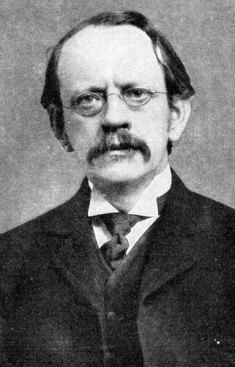| J.J. Thomson | |
|---|---|
 |
|
| Physicist | |
| Specialty | Cathode rays, electrons |
| Born | Dec. 18, 1856 Manchester, England |
| Died | Aug. 30, 1940 (at age 83) Cambridge, England |
| Nationality | British |
Sir Joseph John Thomson, who was generally known as J.J. Thomson, was a British physicist. He was best known for being the man credited with identifying and discovering the subatomic particle that came to be known as the electron. He discovered the electron by means of experimentation with cathode rays, demonstrating that they were made up of negatively charged particles that had been previously unknown to science.
He was also instrumental in the discovery that stable, non-radioactive elements were capable of producing isotopes, as well as being the man who invented the mass spectrometer. Thomson received a number of honors for his work including the 1906 Nobel Prize for Physics, a knighthood, and the Order of Merit.
Early Life and Career
Thomson was born in the Cheetham Hill area of Manchester on December 18, 1856. His father, although a seller of books by trade, had ambitions that his son should go into engineering, and tried to find him an apprenticeship at a local company. He was unsuccessful in his search, and instead enrolled his son at Owens College.
In 1876, he was successful in winning a modest sum of scholarship money, allowing him to go to Cambridge University. Here he attended Trinity College and studied mathematics. In future years, Thomson would be the head of the Cavendish Laboratory at the same college.
After obtaining his degree, Thomson worked under Lord Rayleigh at the Cavendish Laboratory, and his impressive scientific skills were quickly noticed. He was elected a member of the Royal Society, the most prestigious scientific association in the United Kingdom, and by the age of 28 he had been made Cavendish Professor of Physics, succeeding Rayleigh himself in the job.
Thomson combined a brilliant scientific mind with a knack for making friends, allowing him to be both popular and respected. As a result, the laboratory attracted high-caliber students from around the world.
Cathode Rays and the Electron
In the 1890s, many physicists had become interested in the still largely unknown nature of cathode rays, which are light beams that occur after the discharge of electricity in a vacuum chamber, and Thomson joined them in 1894. He was able to develop more accurate methods and better equipment than had previously been available, and this allowed him to get a precise measurement for the angle at which rays were deflected after passing through the vacuum.
From his experimental results, Thomson also discovered that the ratio of electrical charge to the particles’ mass remained constant, no matter what the gas being used. This strongly suggested to Thomson that the relevant particles in the gases were present in all cases.

Extending his work, Thomson established that matter consisted of particles on a scale far smaller than atoms themselves, which he originally named corpuscles, but which came to be known as electrons. His findings dealt the death blow to the existing orthodoxy, which held that atoms themselves were indivisible and the smallest units in existence.
In 1906, Thomson moved to the study of positive rays, which were made up of ions with a positive charge. Six years later, he made a breakthrough when he discovered that the gas neon contained atoms of two different types, thanks to an experiment involving both electric and magnetic fields. This was the first use of mass spectrometry, and demonstrated that even stable, non-radioactive elements could contain multiple isotopes.
Personal Life and Legacy
While at the Cavendish Laboratory, Thomson became increasingly friendly with one of his female students, Rose Paget. The two got married in 1892 and they had two children: a daughter named Joan and a son, George Paget Thomson. This son would eventually go on to become a scientist of great renown in his own right, being knighted like his father and winning the Nobel Prize in 1937 for his work on electron diffusion.
J.J. Thomson was a fairly prolific author, producing about 200 scientific papers and 13 books during his life. He received a knighthood from King Edward VII in 1908, and eight years later accepted the post of Master of Trinity College. His death on August 30, 1940, was somewhat overshadowed by World War Two, but he was still granted the honor of a burial in Westminster Abbey, close to the graves of Isaac Newton and Charles Darwin.